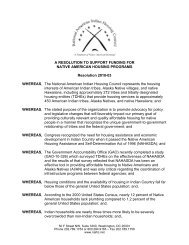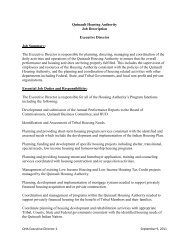CASE STUDY - National American Indian Housing Council
CASE STUDY - National American Indian Housing Council
CASE STUDY - National American Indian Housing Council
You also want an ePaper? Increase the reach of your titles
YUMPU automatically turns print PDFs into web optimized ePapers that Google loves.
The barriers identified by the tribe over the past five years that have impacted theprogram were as follows:• Periodic inability to separate politics from good business practice• Governing bodies lacking expertise• Intergenerational chemical abuse issues• Lateral violence (results of intergenerational poverty and victimization ofmembers within the same community)• Intergenerational unresolved grief issuesConclusionThe goal of the Menominee drug abuse prevention program is to abolish drugactivity and related crimes from Menominee housing communities. The tribe is alsomoving towards expanding its cooperation agreement with the Tribal Police Departmentto increase law enforcement in housing areas and improve data collection to effectivelyassess which services are resulting in reduced drug- and alcohol-related crime. With theabolishment of the <strong>Indian</strong> Drug Elimination Program, the Menominee Tribe will againhave to seek funding to prevent the current program from having a setback. The programwill take a budget cut of approximately $400,000, which will have a huge impact on theMenominee drug elimination program. If the tribe utilizes more NAHASDA funds, thiswill certainly have an impact on the other components of the housing authority as fundingis limited overall.The Drug Elimination Program evolved into a comprehensive program withprevention, intervention, and security. Within the last five years, the Menominee Tribewent from a budget of $229,000 to over $600,000. During this period, the crime indexrate within tribal boundaries has decreased by 17%.Crime prevention and safety activities are an essential component within <strong>Indian</strong>and Alaska Native housing communities for progressive development. A drug- andcrime-free environment will enhance learning and move towards building strong healthy<strong>Indian</strong> housing communities as well as community development. These strongcommunities and community development will, in turn, preserve cultural identity.Contact Information:Executive Director<strong>Housing</strong> DepartmentP.O. Box 459Keshena, Wisconsin 54135Phone 715-799-3236Fax 715-799-430634




